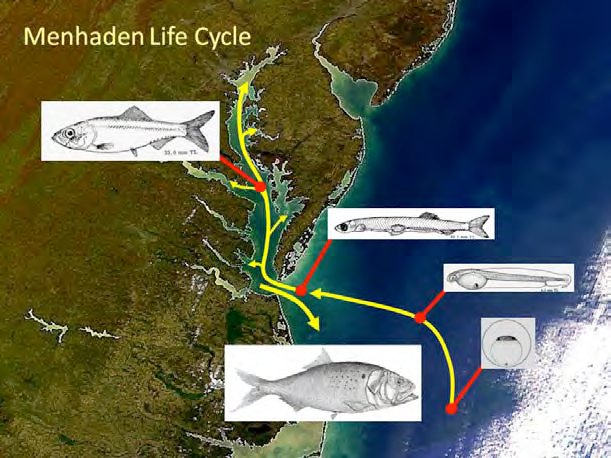Atlantic Menhaden: Ecosystem-Based Reference Points
Forage fishes are important in aquatic ecosystems, consuming vast amounts of plankton while serving as prey for many fish, bird and mammal predators. Atlantic menhaden (Brevoortia tyrannus) is a key filter-feeding forage fish and also the target of the largest single-species fishery in Chesapeake Bay and on the east coast of the USA. Historically, menhaden has been managed without consideration of predator dependency or other ecosystem services that menhaden provides. Consequently, fishing targets and reference points to guide fisheries management have focused solely on achieving high sustainable yields of menhaden.
Menhaden fisheries and management have become controversial as stakeholders seek a more balanced allocation of menhaden to the fishery and its other ecosystem services. As the most prominent forage fish on the US Atlantic coast, menhaden plays a key role in linking plankton to predator production. Precautionary fishing targets and thresholds (termed reference points) to sustain ecosystem services have yet to be developed for Atlantic menhaden.

Conceptual diagram of Atlantic menhaden life stages (ages), factors controlling abundance, and ecosystem services provided by menhaden. The thickness of arrows linking entities indicates relative importance of the link.
The Research
Candidate indicators and reference points are being developed and proposed to support an ecosystem-based approach for management of the Atlantic menhaden fishery on the east coast of the USA.
Objectives and Approach
We are developing, evaluating, and comparing a suite of candidate reference points. The research has three objectives.
Objective 1: Combine fishery-dependent and fishery-independent information on menhaden with oceanographic and climatic data in multivariate statistical analyses to detect environmentally driven temporal and spatial patterns in the distribution and abundance of menhaden, including recruitment variability, and in the spatial distribution of effort and catches in the menhaden fishery.
Objective 2: Develop and evaluate candidate, ecosystem-based reference points for the Atlantic menhaden fishery.
Objective 3: Assess the ecosystem-level consequences of existing single-species reference points, including those specifically recommended for menhaden.


